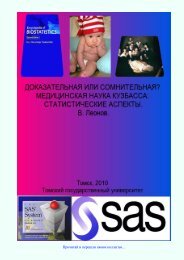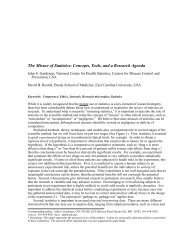Applied Epidemiology Theory to Practice
Applied Epidemiology Theory to Practice
Applied Epidemiology Theory to Practice
You also want an ePaper? Increase the reach of your titles
YUMPU automatically turns print PDFs into web optimized ePapers that Google loves.
<strong>Applied</strong><strong>Epidemiology</strong><strong>Theory</strong> <strong>to</strong> <strong>Practice</strong>Edited byROSS C. BROWNSONDIANA B. PETITTINew York OxfordOXFORD UNIVERSITY PRESS1998
ForewordIn 1949, the <strong>Epidemiology</strong> Section of the American Public Health Associationcelebrated its twentieth anniversary in a session on "The His<strong>to</strong>ry of American<strong>Epidemiology</strong>." John Gordon, chairman of the Department of <strong>Epidemiology</strong>at the Harvard University School of Public Health, spoke on "The Future in<strong>Epidemiology</strong>." He defined the province and promise of epidemiology insuccinct and comprehensive terms:As the diagnostic discipline of public health, epidemiology should find increasingusefulness in the definition of health problems, in determining principles <strong>to</strong>guide programs for control, and in evaluation of accomplishment. The promiseof a more scientific and a more statesmanlike public health has a close relationshipwith operational epidemiology.*More than 30 years later, in an article on "<strong>Epidemiology</strong> and the PublicHealth Movement: A His<strong>to</strong>rical Perspective," Abraham and David Lilienfeldnoted that:During the past two decades, the discipline of epidemiology has become increasinglydivorced from those activities in the real world that result in theimprovement of public health. Public health administration was at one timeintimately associated with epidemiology. . . . Our excursions in the his<strong>to</strong>ricaldevelopment of epidemiology have led us <strong>to</strong> realize that epidemiology is closelyinterwoven with the public health movement, and our study of the evolution ofthe public health movement has indicated that its roots must be firmly implantedin an epidemiologic base. In order <strong>to</strong> continue with the past successes ofboth movements, they must be constantly nourished by each other.The great need for a textbook that teaches epidemiology as "the diagnosticdiscipline of public health," a textbook that is concerned with "usefulness inthe definition of health problems, with determining principles <strong>to</strong> guide programsfor control, and with evaluation of accomplishment," becomes abundantlyclear when one reviews the content of leading textbooks in the field.*Winslow, C.-E. A., Smillie, W. G., Doull, J. A., and Gordon, J. E., edited by Top, F. H. TheHis<strong>to</strong>ry of American <strong>Epidemiology</strong>. St. Louis: C. V. Mosby, 1952.Lilienfeld, A. M., and Lilienfeld, D. E. "<strong>Epidemiology</strong> and the Public Health Movement: AHis<strong>to</strong>rical Perspective," J. Public Health Policy 3 (1982): 140-49.VII
viiiForewordFor example, the third (1994) edition of Foundations of <strong>Epidemiology</strong>, revisedby David Lilienfeld and Paul S<strong>to</strong>lley, resembles its previous editions in that itprovides practically no discussion of the use of epidemiology in public healthpractice. On the other hand, as the authors state, "a new chapter on the use ofepidemiologic information in clinical settings has been added <strong>to</strong> this edition."The new chapter has two sections: (1) Clinical Decision Making and (2)Reading and Interpreting Scientific Literature.In sharp contrast, <strong>Applied</strong> <strong>Epidemiology</strong>: <strong>Theory</strong> <strong>to</strong> <strong>Practice</strong> considers epidemiology<strong>to</strong> be, as John Gordon said, "the diagnostic discipline of publichealth." Its 12 chapters provide a thorough and comprehensive analysis ofproblems, issues, and methods, and describes the advantages and disadvantagesof various alternative approaches. In addition, the case studies of actualprograms which conclude each chapter emphasize the authors' orientation <strong>to</strong>the real world of public health practice.<strong>Applied</strong> <strong>Epidemiology</strong>: <strong>Theory</strong> <strong>to</strong> <strong>Practice</strong> is the book that the public healthmovement has been waiting for. It will be treasured by every public healthworker who needs state-of-the-art information and guidance in defininghealth problems and attempting <strong>to</strong> solve them. It needs <strong>to</strong> be studied bypolicy-makers in all levels of government, in the schools of public health, andin the state and national public health associations. There has been no recognitionof the crucial need for a large-scale program of federal aid <strong>to</strong> remedy thesevere shortage of trained epidemiologists in state and local health departments,and <strong>to</strong> finance the development of a truly adequate information systemthat will provide health departments with the data required for effectiveplanning and moni<strong>to</strong>ring of programs and services. Commitment and leadershipby the public health movement are essential <strong>to</strong> convince federal administra<strong>to</strong>rsand the Congress of the rich promise of epidemiology so clearlydemonstrated by this landmark volume.Mil<strong>to</strong>n Terris, MD, MPH
PrefaceThese are exciting times for epidemiology. Because of the increasingly largedemand for epidemiologic expertise and the many advances in epidemiologicmethods, both the opportunities and challenges in this field have never beengreater. The advances in epidemiologic methods afford more sophisticatedways <strong>to</strong> evaluate the health risks associated with many exposures and withenvironmental contaminants in modern society. New information technologies,including powerful microcomputers, software, and the Internet, offerexciting opportunities for the conduct of a broader array of studies. Changesin how health care is delivered, particularly the growth of organized systemsof care, open new chances for epidemiologists <strong>to</strong> become involved inpopulation-based medicine and the assessment of health care utilization andquality. Despite the vast potential of epidemiology, decisions are frequentlymade and policy is often formed in the absence of sound epidemiologic dataand scientific reasoning.The need for this book became clear as a result of the authors' day-<strong>to</strong>-daywork in public health and health care, experiences in the classroom, anddiscussions with colleagues. Individual epidemiologists and several expertadvisory bodies have called for stronger links between educational institutionsand public health practice: One link may include a curriculum in epidemiologythat more closely reflects the day-<strong>to</strong>-day practice of public health.In our view, applied epidemiology synthesizes and applies the results ofetiologic studies <strong>to</strong> set priorities for intervention; it evaluates public healthinterventions and policies; it measures the quality and outcome of medicalcare; and it effectively communicates epidemiologic findings <strong>to</strong> health professionalsand the public. Within this broad framework, the chapters in thisbook were chosen <strong>to</strong> emphasize some of the areas of public health practice inwhich systematic application of epidemiologic methods can have a large andpositive impact. A major goal is <strong>to</strong> extend the scope of more traditionalepidemiology books that tend <strong>to</strong> focus only on methods for determiningdisease etiology (e.g., study design, sources of bias, causal reasoning).Following an introduc<strong>to</strong>ry chapter, three overview chapters deal withstudy design and interpretation, methods in outbreak and cluster investiga-IX
xPrefacetions, and principles of public health surveillance. The remaining eight chapterscover important contemporary <strong>to</strong>pics that have strong conceptual ormethodologic linkages with epidemiology. The chapters are designed <strong>to</strong> highlightkey issues and <strong>to</strong> provide practical recommendations. Case studies at theend of each chapter illustrate major points and provide a basis for teachingexercises. Each case study follows a standard format (i.e., background, keyquestions, and implications for practice).Topics covered in this book underline the multidisciplinary nature ofepidemiology. Even within the overall science of epidemiology, there are anumber of subdisciplines, such as clinical epidemiology, behavioral epidemiology,occupational epidemiology, chronic disease epidemiology, infectiousdisease epidemiology, and environmental epidemiology. In this regard,our book is intended <strong>to</strong> complement other recent Oxford texts in epidemiologyand biostatistics.The target audience for this text includes practicing epidemiologists, studentsin epidemiology, and practitioners and students in related disciplinesthat rely heavily on epidemiologic methods and reasoning. We hope the bookwill be useful in academic institutions, state and local health agencies, federalagencies with significant training missions, and health care organizations.Although the book is intended primarily for a North American audience,examples are drawn from all parts of the world and we believe that much ofthe information will be applicable in any developed or developing country. Ifused in course work, the students should already be familiar with the basicconcepts in epidemiology.Epidemiologic reasoning and methods inevitably will move beyond theboundaries of etiologic research and become integral <strong>to</strong> the practice of publichealth and the delivery of health care. We believe this book will be a usefulresource.August, 1997 R. C. B.D. B. P.
AcknowledgmentsWe are grateful <strong>to</strong> have chapters contributed by some of the <strong>to</strong>p researchersand practitioners in the fields of epidemiology and public health: Andy Amster,Thomas A. Burke, Jennifer L. Kelsey, Abby C. King, Thomas D.Koepsell, Patrick L. Reming<strong>to</strong>n, Jonathan M. Samet, Donna F. Stroup,Steven M. Teutsch, Stephen B. Thacker, and Benedict I. Truman.Many others contributed <strong>to</strong> the development of this book or reviewedearlier drafts of chapters. Our thanks <strong>to</strong>: Elena M. Andresen, James R.Davis, Ronald M. Davis, Kathleen N. Gillespie, Richard A. Goodman, RichardF. Hamman, Garland Land, James S. Marks, Raymond R. Neutra,Charles Poole, Kenneth J. Rothman, Mervyn Susser, and Fredric D.Wolinsky.Finally, special thanks <strong>to</strong> Jeffrey House, Oxford University Press, whoprovided valuable advice and ideas throughout the genesis and production ofthis book.XI
This page intentionally left blank
ContentsContribu<strong>to</strong>rs, xv1. <strong>Epidemiology</strong>: The Foundation of Public Health, 3Ross C. Brownson2. Key Methodologic Concepts and Issues, 35Jennifer L. Kelsey, Diana B. Petitti, and Abby C. King3. Outbreak and Cluster Investigations, 71Ross C. Brownson4. Public Health Surveillance, 105Stephen B. Thacker and Donna F. Stroup5. <strong>Epidemiology</strong> and Risk Assessment, 137Jonathan M. Samet and Thomas A. Burke6. Epidemiologic Issues in the Design of CommunityIntervention Trials, 177Thomas D. Koepsell7. Screening in the Community, 213Benedict I. Truman and Steven M. Teutsch8. Epidemiologic Issues in Outcomes Research, 249Diana B. Petitti9. Economic Evaluation, 277Diana B. Petitti10. Measuring the Quality of Health Care, 299Diana B. Petitti and Andy Amster11. Communicating Epidemiologic Information, 323Patrick L. Reming<strong>to</strong>n12. <strong>Epidemiology</strong> and Health Policy, 349Ross C. BrownsonIndex, 389XIII









